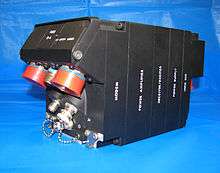AN/ARC-210

The ARC-210 is a family of radios for military aircraft that provides two-way, multi-mode voice and data communications over a 30 to 512+ MHz frequency range. It covers both Ultra High Frequency (UHF) and Very High Frequency (VHF) bands with AM, FM and SATCOM capabilities.[1] The ARC-210 radio also includes embedded anti-jam waveforms, including Havequick and SINCGARS, and other data link and secure communications features, providing total battlefield interoperability and high-performance capabilities in the transfer of data, voice and imagery. It features a separate guard receiver for monitoring 121.5 and 243 MHz while simultaneously monitoring the active channel selected. Transmitter power ranges from 5 to 23 watts, depending on frequency and mode. The radios communicates with other avionics over a MIL-STD-1553 data bus.
The ARC-210s are manufactured by Rockwell Collins and are installed in a wide range of aircraft, helicopters and ships across all five U.S. military services. The ARC-210 program began in 1990 and is installed on more than 180 platforms worldwide and is operating in more than 40 countries. As of 2010, 30,000 had been produced.[2] The radios have generated over $2 billion in sales for the company.[3]
There have been five generations of the radios.[4] Models include the RT-1556, RT-1794, RT-1824, RT-1851, RT-1851A, and RT-1939. The earliest model covered 30-400 MHz. The fifth generation RT-1939 is one of the first military radios to have software-programmable encryption under the National Security Agency’s (NSA) Cryptographic Modernization Initiative. Its frequency range is extended and includes the following bands:
- VHF 30-88 MHz close air support
- VHF 108-118 MHz navigation
- VHF 118-137 MHz air traffic control
- VHF 137-156 MHz land mobile
- VHF 156-174 MHz maritime
- UHF 225-512 MHz military/homeland defense
- UHF 806-824, 851-869, 869-902, 935-941 MHz public safety bands
Continuous Tone-Coded Squelch System (CTCSS), used by many public safety agencies, is available above 400 MHz and below 88 MHz.[4]
The transceiver weights about 12.2 lb (5.53 kg). Available accessories include remote controls, transmit power amplifiers, receive low noise amplifiers, and ground support equipment.
See also
- AN/ARC-231, similar radio produced by Raytheon
- List of military electronics of the United States
References
- ↑ http://www.rockwellcollins.com/sitecore/content/Data/Products/Communications_and_Networks/Communication_Radios/AN-ARC-210_Gen_V_Programmable_Digital_Communication_System.aspx[
- ↑ "Archived copy". Archived from the original on 2016-03-04. Retrieved 2013-03-01.
- ↑ http://www.rockwellcollins.com/sitecore/content/Data/News/2010_Cal_Yr/GS/FY10GSNR17_ARC-210_30000_Delivery.aspx
- 1 2 http://www.afceaboston.com/documents/events/cnsatm2011/Briefs/02-Tuesday/Tuesday-PM%20Track-2/04-Maher-ARC-210%20Program%20Overview-Tuesday%20Track2.pdf